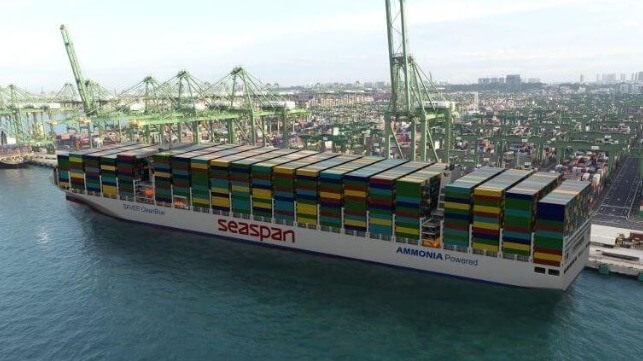Maersk Mc-Kinney Moller Center Unveils Ammonia-Fueled Boxship Design

The Maersk Mc-Kinney Moller Center for Zero Carbon Shipping and its partners have unveiled the design for a new 15,000 TEU ammonia-powered container ship, which will be part of a new study on ammonia bunkering in Singapore.
Shipowner Seaspan Corp. has been leading the design project for the vessel, working with the Maersk Mc-Kinney Moller Center, ABS and design house Foreship. No further details are currently available. The vessel is conventional in appearance: It has 21 forty-foot bays, making it slightly shorter than the Emma Maersk, the first ship ever built in the 15,000 TEU size range. The house is separate from the stack and located five bays aft from the bow. While this is four rows further forward than similarly-sized boxships like the CMA CGM Argentina-class, it is not a radical house-forward design like Maersk's new methanol-powered ULCV.
Other ammonia boxship projects are also in the works. MSC has announced plans to design a smaller 8,000 TEU ammonia vessel in partnership with CSSC, MAN and LR, based on an existing hull form.
Bunkering studies
The new Seaspan/Maersk Mc-Kinney Moller Center boxship project is part of the scope of the SABRE Consortium, a partnership focused on developing and demonstrating an ammonia supply chain in Singapore.
In May 2022, the consortium secured an AIP from ABS for an ammonia bunkering vessel, and the partners hope to begin operations by 2030. The list of deliverables includes feasibility studies, new contractual terms, procedural standards, and the boxship design unveiled Tuesday. It is expected that the Center will have ownership of the vessel design, either in its entirety or together with its partners. The full list of participants also includes A.P. Moller – Maersk, Fleet Management Limited, Keppel Offshore & Marine, Sumitomo Corporation, Kawasaki Kisen Kaisha (K Line) and the Maritime and Port Authority of Singapore (MPA).
Singaporean authorities recently put the brakes on the launch of a separate, parallel ammonia-bunkering trial, citing safety concerns. In April, a study from the Global Centre for Maritime Decarbonisation (GCMD) concluded that ammonia's risks were low and manageable, and that it should be possible for GCMD to proceed with its own pilot trials for bunkering and fuel handling by the end of 2023. Singapore's Maritime and Port Authority (MPA) pushed back, stating that it did not agree and that "the timeline before end-2023 is not realistic." The agency said that it would be necessary to wait for an ongoing regulatory review and standard-setting process to finish, and pointed to other research suggesting the need for more safety studies on dispersion in the event of a leak.
